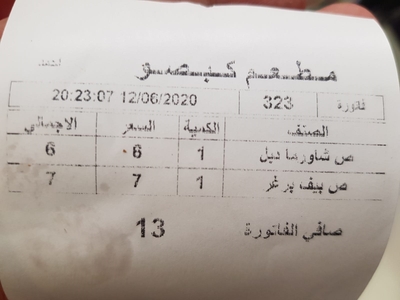In light of the depreciation of the Syrian pound, parts of northern Syria outside the control of the Damascus-based government have taken steps to move towards the Turkish lira currency that is more stable against the U.S. dollar, with the insertion of quantities of Turkish lira currency into those areas. One such area is the north Aleppo countryside area under Turkish influence ('Euphrates Shield' and 'Olive Branch' zones). To discuss the issue of currency use in that area, I conducted an interview with Ahmad Walid of Azaz. This interview was conducted on 10 June 2020. It is slightly edited and condensed for clarity. Any parenthetical insertions in square brackets are my own.
 A restaurant receipt from Azaz using Turkish liras. June 2019. Photo supplied by a local friend. |
Q: Currently are most transactions in Azaz in the Turkish lira?
A: A proportion of 50% in Turkish lira.
Q: Has the use of the Turkish lira led to the improvement of the living situation among the people?
A: Brother the situation will not improve until the exchange price stabilises or the region deals entirely in the Turkish lira.
Q: Do you mean the exchange price between the dollar and the Syrian pound?
A: The dollar and Turkish lira as opposed to the Syrian pound.
Q: What prevents the entire transition to the Turkish lira?
A: The business between the free areas and the regime areas, and there are employees who take salaries from the regime until now.
Q: So you don't expect an entire transition to the Turkish lira.
A: I don't expect.
Q: In the opinion of the people of Azaz what are the reasons for the collapse of the Syrian pound?
A: The talk of the street is manifold. Some people think the disagreement between Rami Makhlouf and Bashar al-Assad has made the economic situation worse, and the other opinion is that the Caesar law has impacted the economic situation.
Q: Do most of the people of Azaz support the Caesar law?
A: They support it if it has a positive result on the fall of the regime.
Q: Can you give examples of the transactions that use the Turkish lira?
A: Electricity, water, food goods in the Turkish currency, building materials in the dollar, and vegetables and meats in the Syrian pound.
Q: Why the vegetables and meats in the Syrian pound?
A: The livestock and vegetable merchants until now work by the Syrian pound because their produce is local.
Q: Can you give examples of the increase of the prices [in Syrian pounds] of the vegetables and meats because of the rise of the price of the dollar?
A: Sheep meat: 14000. Cow meat: 12,000. Chicken meat: 4000. Tomatoes: 1300. Eggplant: 1300. Cucumbers: 800. Garlic: 4000.
Q: And what were the prices a month ago?
A: Approximately they have increased by one third.

